Armored vehicles of Germany in the Second World War. Jagdpanzer IV tank destroyer (Sd.Kfz.162)
The success of the StuG-40 and German-made StuG III Ausf F assault guns gave self-propelled tank destroyers an impetus for development. A well-protected car with a low silhouette was necessary. Initially, the new tank destroyer was called “neu Sturmgeschütz” (“new assault gun”), that is, the creators of the machine did not yet distinguish self-propelled tank destroyers and assault artillery.
However, it soon became clear that it would take much longer to create a new assault gun. They promised to build a prototype by the middle of 1943. In connection with this, Vomag AG proposed a new tank destroyer based on the chassis of the medium tank Pz.Kpfw. Iv. This machine was called Jagdpanzer IV Ausf F (Sd.Kfz. 162) and was armed with 75-mm 7.5 cm Pak 39 L / 48 mm cannon.
It was planned to create a fighter tank on the chassis StuG III / 40. Alkett has proposed three types of vehicles that carry different weapons.
However, it turned out that too serious alterations are needed, so it was decided to create a new car on the chassis of the Pz.Kpfw tank. Iv.
2 October 1942 was shown to Hitler by the new car, called Sturmgeschütz auf Fahrgestell Pz.Kpfw. IV mit der 7.5 cm KwK 42 L / 70. The tank destroyer had thicker armor, and the frontal armor plate was placed at an angle. The 7.5 cm KwK 42 L / 70 gun was mounted in a mask directly in the frontal armor of the cabin, and was not attached to the floor, as was the case with assault guns.
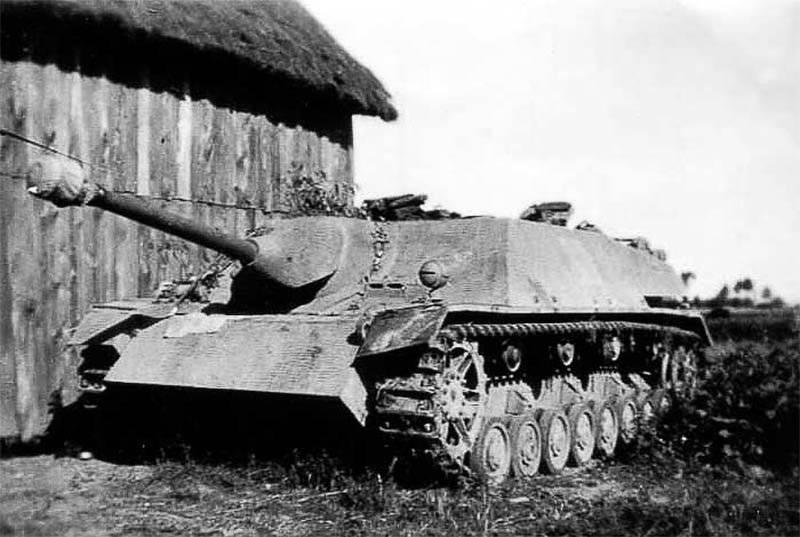
A. Hitler agreed with the opinion that before the start of mass production of the 75-mm long-barreled cannon, conventional 7.5 cm Pak 39 L / 48 will be installed on tank destroyers. In addition, he ordered in the shortest time possible to abandon the old gun in favor of the long-barreled gun.
The production of new weapons was deployed in Plauen, Saxony on Voglandische Maschinenfabrik AG. A full-size wooden prototype SAU was demonstrated to the 13.05 Führer. 1943 in Aris at the site.
The height of the tank destroyer was only 1700 (1720) millimeters, which made it possible to act imperceptibly. The gun was mounted in a spherical mask, which allowed to abandon the complex mechanism of vertical guidance. Frontal cutting felling is a plate, 80 mm thick, inclined at an angle of 15 degrees, capable of withstanding a hit by 76-mm projectiles of American and Soviet cannons.
20.10.1943 in East Prussia at the Aris proving ground presented a prototype with a wheelhouse made of non-armored steel. Soon after this, Hitler ordered the launch of mass production of these tank destroyers.
Vomag collected two more prototypes at the end of 1943. The prototypes, as well as the null-series machines, compared with subsequent serial production machines, had a rounded connection of the onboard and frontal armor of the cabin. In serial tank destroyers, armor plates were tied in the same way as in Pz.Kpfw. IV, which increased the strength of the connection of armor plates.
Curiously solved the issue with the use of auxiliary weapons. From the gun on both sides there were two loopholes. The right loophole was used for firing from the MG-42 machine gun, and the left loophole could be used by the crew for firing from the MP-44 assault rifle or the MP 40 submachine gun.
The tank destroyer was largely unified with the Pz.Kpfw tank. IV, from which the car inherited the hull, transmission, chassis, electrical equipment and engine. Compared with the tank, Pz.Kpfw. IV The position of the fuel tanks was changed. In the tank, the tanks were located under the polycom of the combat compartment, and in the Jagdpanzer IV tank destroyer they were located under the gun and in the place of the gunner-radio operator. An additional tank was placed on the site of the two-stroke DKW, which rotated the turret at the tank. The ventilation scheme of the fighting compartment was modified, as well as the brakes that were now blown from the engine compartment. The location of the evacuation hatch was also changed, now it was under the gunner’s seat.
60 mm frontal armor was set at an angle of 40 degrees.
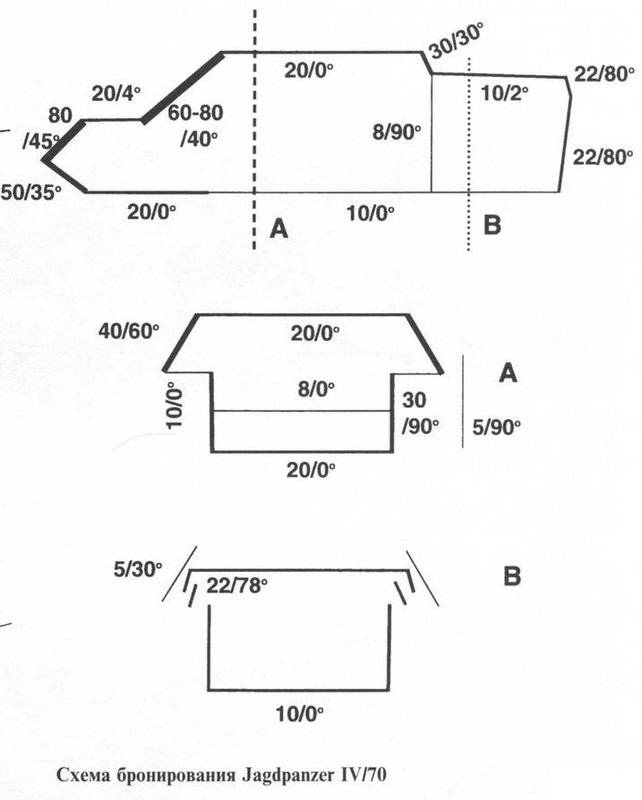
Modifications and production
Two cars of the zero series were equipped with a modified gun mask. In January, 1944 was the first modification of production machines. A grenade launcher Nahvertiedigungswaffe was installed in the roof of the wheelhouse near the gunner's hatch.
In February of the same year, on the frontal armor, there were installed mounts intended for 14 spare track tracks. In the spring, spare trucks were moved to the stern. This is done to unload the front of the machine. However, the attachments from the frontal armor were not removed, but the tracks did not cling to them. At the stern an extra pair of spare track rollers was placed.
In March, 1944 was tightly brewed left loophole in frontal armor. Machines that were produced in late March and early April of the same year, equipped with Rundumfeuer Maschinengewehr - MG-42 machine gun - mounted on a special machine on the roof of the cabin. The machine gun was serviced from a gunner’s place remotely. At the same time, the gun mask was modified.
Starting with the machines with chassis number Fgst 320301, the frontal armor was increased from 60 to 80 millimeters, and the side armor - from 30 to 40 millimeters. Left loophole was missing. Cars that were released before the end of May, had a muzzle brake. However, the muzzle brake in combat units was usually removed, because it caused dust to rise during firing, making it difficult to aim and unmask the machine. Spare support rollers were transferred to the control plate. The periscope mount was also changed.
Some cars in the summer of 1944, received armored hoods for air intakes of the engine cooling system.
The last modification was carried out in September 1944. Three all-metal support rollers were installed on the tank destroyers instead of four rubberized ones. At the same time, they refused to use tsmmerita for coating armored vehicles.
Some of the tank destroyers of the Jagdpanzer IV were produced in the Befehlswagen variant (commander version). The crew of the command vehicle consisted of five people, and the car was equipped with a radio station FuG 8. In September, 1944 built two prototypes, which were armed with a fixed neu Starr 7.5 cm Pak 39 L / 48 cannon, but found difficulty in firing, so further testing of this art system was performed using the Hetzer Jagdpanzer.
Serial production began in January 1944, when 30 cars were built. In October 1944, the release was completed. In November, an additional two Jagdpanzer IVs were assembled. As a result of raids aviation allies at Vomag AG and allied companies such as Zahnradfabrik AG in Friedrichshafen, where gearboxes were produced, the output speed was lower than planned. The peak of production occurred in July (140 pcs.) And June (120 pcs.) 1944. In April, Vomag AG ceased production of Pz.Kpfw tanks. IV, switching to the production of fighters.
In August, 1944 began the transition to the production of machines armed with 75-mm long-barreled gun 7.5 cm KwK. 42 L / 70. The transition was made smoothly, the production of old, equipped with a short gun, tank destroyers Jagdpanzer IV declined gradually. A total of 804 machines of this type were produced.
Components for a fighter tank Jagdpanzer IV supplied by the same companies supplying parts for tanks Pz.Kpfw. Iv. Bronelist supplied Witkowitzer Bergbau und Eisenhuetten Gewerkschaft, weapons company Rheinmetall-Borsig and Seitz.
Description of construction
The layout of the fighter tank Jagdpanzer IV standard. In the front part, to the left of the gearbox, there was a driver's seat. At the starboard in the center of the fighting compartment, there was a gunner-radio operator, who served a course machine gun. At the left side were the workplaces of two more crew members: the gunner was in front, the commander was behind him. The seat of the car commander was located under a round hatch in the wheelhouse. In the fighting compartment in the far right corner there was a loader, over which a second hatch was made. An evacuation hatch (diameter 440 mm) is placed under the gunner’s seat.
The cabin and hull were welded from heterogeneous rolled armor plates. At different sites the thickness of the armor fluctuated.
The armor was manufactured by the Dortmunder-Huehler & Co company in Kapfenberg and the steel mill in Vitkovice. The armor plates were joined together by welding. The armor plates were also joined by welding to the hull frame, which was assembled from steel profiles.
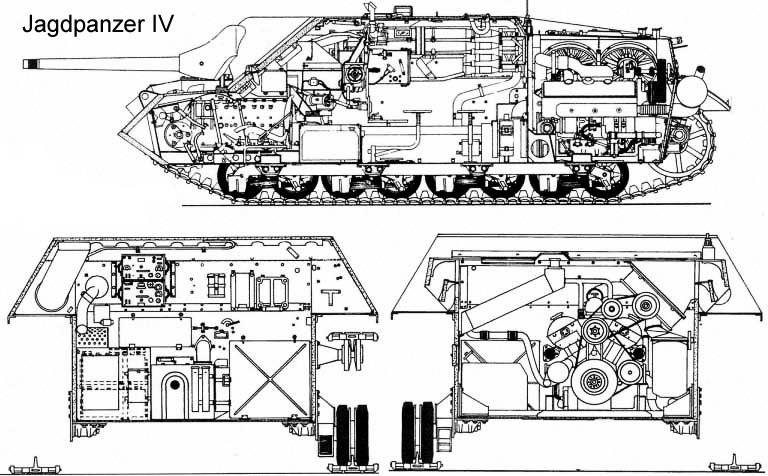
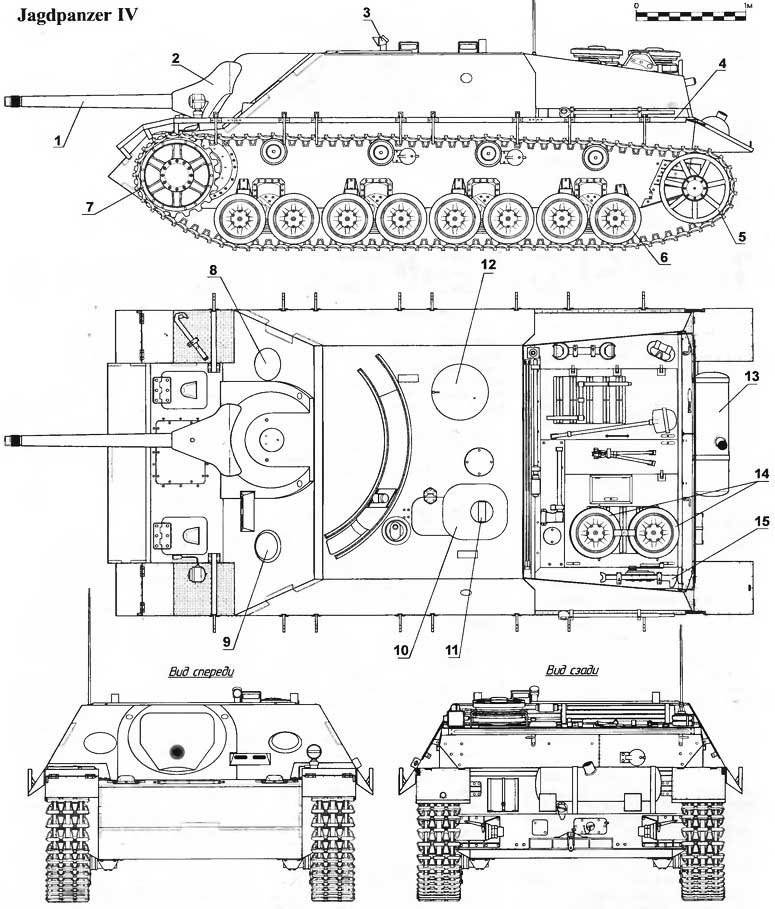
Engine
On the Jagdpanzer IV installed four-carburetor V-shaped 12-cylinder overhead valve Maybach HL 120 TRM with liquid cooling. Engines were supplied by companies, including Maybach Motorenwerke (Friedrichshafen) and Auto-Union AG (Chemnitz). The cylinder diameter is 105 millimeters, the piston stroke is 115 millimeters, the displacement is 11867 cm³. Cast pistons have a gap from 0,12 to 0,16 millimeters. The compression ratio is 1: 6,5. The maximum revolutions per minute for 3000 are recommended - 2600 revolutions per minute (after the overhaul of 2200 – 2400 revolutions per minute). Engine power at 3000 rpm 221 kW (300 hp), at 2600 rpm 195 kW (265 hp). Torque at 2150 rpm 80 µg. Specific power 9,20 kW / t (12,5 hp / t). Two radiators with a total surface area of 2,6 m² were located on the sides of the motor. Forced circulation is carried out by a Pallas type pump. The coolant has an operating temperature of 80 °, while the maximum temperature is - 90 °.
The machines were equipped with a hot antifreeze overflow system from working machines to those that were started up, to facilitate start-up in the cold.
In the engine compartment, air circulation was provided by two Zyklon-type fans, each of which had two air filters. The fans were located on the right side of the engine compartment above the engine. Fans took power from the engine. There were a couple of air vents on the over-engine armor plate, which were closed with armored louvres at later-release fighter jets. Outgoing and incoming openings in the engine compartment for air flow were made in the sides of the hull. Blinds associated with a thermostat, regulated flow. Fuel - leaded petrol OZ 74, octane number 74. Three fuel tanks had a total capacity of 470 liters, a working capacity - 463 liters. The fuel supply was provided by two Solex gasoline pumps, and a manual emergency pump. All three tanks had a common throat, and the fuel tank switch was located at the driver’s dashboard. On the highway, the fuel consumption on the 100 km was 220 liters, and on rough terrain 360 l. The capacity of the oil tank was 22 liters.
The engine had two Solex 40JFF II carburetors. Two propeller shafts were used to transfer torque from the engine to the box. The main clutch is dry, three-disc, type Fichtel & Sachs 120 / HD. The ZF Aphon SSG76 planetary gearbox had six forward gears and one reverse. Gear shifting was carried out using a lever, which is located to the right of the driver's seat. The driver had a set of control and indicating devices. The driver-mechanic controlled the tank destroyer using pedals and levers. The steering system worked on the clutches through a hydraulic transmission. The planetary turning mechanism made it possible to turn the tank destroyer, brake, and also carry out other maneuvers. The torque was then transmitted to the bot gears (gear ratio 1: 3,23). The drive wheels were operated by Krupp mechanical brakes.
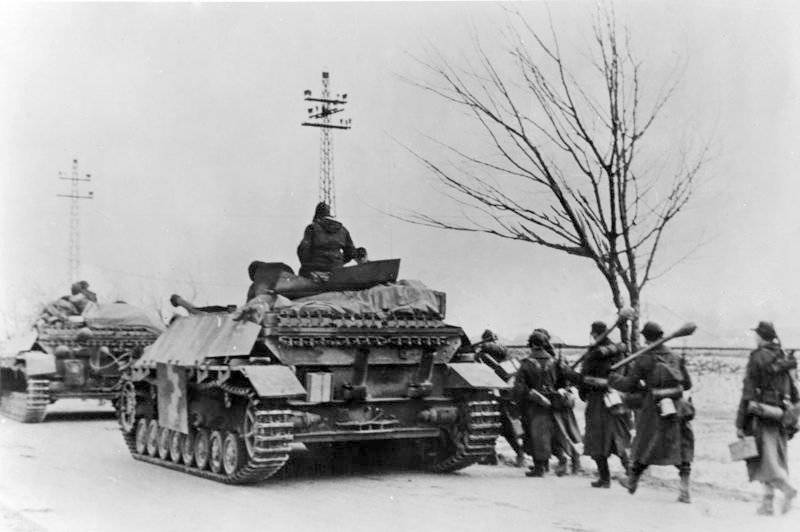
Electric equipment
Wiring single-core. Line voltage 12 B. The current source is a Bosch GTLN 600 / 600-12 1500-watt generator. An additional current source is four Bosch 12B type 105 batteries (6 V voltage, 105 A / h capacity). Two starters Bosch BNG 4 / 24 operating voltage 24В, power 2,9 kW (4 hp). Spark plugs Bosch W225N1. Electric ignition, cylinders operate in series 1 – 12 – 5 – 8 – 3 – 10 – 6 – 7 – 2 – 11 – 4 – 9. It is possible to start the engine using the handle, which is rotated by two crew members. The handle was inserted into the hole in the aft armor plate in its lower part. In addition, it was intended to use a Bosch AL / ZM I starter-less starter. The tank engine could be started using the Kübelwagen car engine.
In the on-board network, consumers were the illumination of control devices and a sight, a headlight (on the front left fender), a sound signal, a radio station, the launch of a machine gun and guns, the running light Notek.
Chassis
The undercarriage of the Jagdpanzer IV tank destroyer consisted of eight support rollers of small diameter (size 470 × 75-660), which are assembled into four suspension trucks in pairs. The upper part of the caterpillar lay on four supporting rollers (in later machines on three all-metal). The drive wheel was located in the front, and the track tensioning mechanism and the steering wheel - in the stern. The drive wheel had 20 teeth. Support and track rollers had a rubber coating. Single-track caterpillars with separate tracks. Trucks were made of manganese steel. Tracks type Kgs 61 / 400 / 120, width 400 millimeters. The reference length 3520 millimeters, the length of the chain 99 tracks, gauge 2450 millimeters. The tracks were made by the Hamburg company Moorburger Trackenwerke. Provided the ability to wear anti-slip teeth on the tracks. In autumn and winter, wider Ostenkette caterpillars were used. Track weight Ostenkette 1750 kg, normal - 750 kg.
Radio equipment
The standard radio equipment included a FuG 5 SE10U transceiver and a 10 WSa transmitter or an 10 cotton 10 WSb transmitter, operating in the 27,2 to 33,3 MHz range, which has a “c” receiver (later “e”), which also operates in the UHF band. The transmitter worked through the transformer U 10, the receiver - E Ua. In the telephone mode, the range of the radio station was 6400 m, in the key mode - 9400 m. The FuG 5 radio station was installed at the starboard side of the anti-vibration stand near the charging point. A two-meter whip antenna was pulled out to the left side.
In addition, tank destroyers were equipped with a set of signal flags, as well as the Walther LP (Lauchpistole) or LP-27 42-mm rocket launcher, which was stored near the commander’s seat.
weaponry
Armament Jagdpanzer IV: 75-mm 7.5cm Pak 39 L / 48 cannon and MG-7,92 42-mm machine gun. The gun and machine gun were equipped with an electric descent. Standard gun ammunition included 50% Pz.Gr. shots. 40 (subcaliber) and 50% shots Pz.Gr. 39 (armor piercing). Ammunition was located in the rear of the fighting compartment in the styling, behind the gas tank and under the gun in the right side of the compartment.
Variants of masks guns fighter tank Jagdpanzer IV.
Armor-piercing shell Pz.Gr. 39 had an initial speed of 790 m / s with a weight of 6,8 kg. At a distance of 100 meters, this projectile was pierced with 106-mm armor installed at an angle of 30 degrees, at a distance of 500 meters - 96-mm, at a distance of 1000 meters - 88-meters, and at a distance of 2000 meters - 64-mm.
At distances 100 and 500 m, the accuracy of fire was 100%, at distances 1 thousand meters - 97%, at distances 1,5 thousand meters - 77%. But in combat conditions, the accuracy of fire at a distance of 1 thou. M was taken equal to 78%, at a distance of 1,5 thou. Meters only 29%. These figures correspond to shooting with a stop.
Also, Pz.Gr. sub-caliber shells were used. 40 weighing 4,1 kg having an initial speed of 990 m / s. At distances 100, 500, 1000 and 2000 meters, the sabot projectile pierced an armor plate with a thickness of 143 mm, 120 mm, 97 mm and 77 mm, respectively. Accuracy is directly dependent on the speed of the machine. Accuracy at a speed of 15 kilometers per hour decreased by 21%, at a speed 25 kilometers per hour - by 33%. The accuracy of fire at a distance of 1,5 thousand meters was only 12%. Ammunition consisted of 79 shots. The elevation / declination angle is + 15 ° ... -5 °, the shelling sector 20 ° in the direction of the gun from the gun.
The MG-7,92 42 mm machine gun of caliber was located in the fighting compartment on the right-hand side. Initially, machine gun ammunition was stored on 150 cartridges in canvas bags. Standard ammunition - 1,2 thousand rounds. Later, the ammunition was stored in the fighting compartment at the bottom in aluminum boxes.
Additional weapons are the 9-mm MP-40 submachine gun or the MP-44 assault rifles of the 7,92 mm caliber with 12 rocket ammunition. Some tank destroyers were armed with a Nahverteidigungswaffe X-gun 16-mm fragmentation grenade launcher.
Optical devices
Jagdpanzer IV had a Selbstfahrlafetten-Zielfernrohr la telescopic sight, which was calibrated from 0 to 1500 meters (Pz.Gr. 39) and from 0 to 2000 meters (Pz.Gr. 40). The sight was provided with a fivefold increase, the field of view was equal to 8 degrees.
A gun machine gun was equipped with a KZF 2 sight (increase in 1,8 ×, calibration in the range from 0 to 1200 meters). The release of sights involved the company Carl Zeiss Jena. The driver had a Fahrer 2 Winkelspiegel binocular periscope. The loader's place was equipped with a fixed periscope Rblf 3b and the commander with three periscopes Scherenfernrohr 14Z.
Additional equipment
Add. The equipment consisted of tools that were attached to an extra-engine plate. The fire extinguisher in the first production vehicles was located on the right wing in front. On machines of later series, the arrangement of tool boxes and fixtures was transferred to the fences. A tackle tool (pickaxe, shovel and scrap) was attached to an extra-engine plate. The car was completed with a first-aid kit and two (three) fire extinguishers that were stored in the fighting compartment. A jack was placed on the engine plate, as well as a hand pump used for pumping gas from barrels. On the rear wall of the cabin was a folding bannik. The composition of the add. equipment included cans of water and gasoline, canvas covers, a bucket and more.
The organization of parts and the combat use of tank destroyers Jagdpanzer IV
In the spring of 1944, the first serial fighter aircraft of the Jagdpanzer IV tanks began to enter combat units.
As a rule, they were used as part of Panzerjager Abteilung - divisions of tank destroyers. Divisions were formed in accordance with the KStN 1149 Ausf schedule. A from 1 February 1944 g. The division consisted of two combat companies. Each company consisted of 14 machines, three more were part of the headquarters company of the division. Total, the division included the 31 tank destroyer.
Divisions of tank destroyers included in the tank divisions had a slightly different state. In the tank division company there was only 10 Jagdpanzer IV (three platoons, each with 3 vehicles and a company commander’s vehicle), the division commander had another tank destroyer. In total, the Jagdpanzer IV division of the tank division included 22 vehicles.
17 in March. The Panzer-Lehr-Division’s 100th Division received the 31 tank destroyer Jagdpanzer IV. The thirty-eighth division of tank destroyers. In April, the Second Tank Division received the 21 machine. It was planned that the Panzer-Lehr-Division's Tenth Division would include two companies of tank destroyers: Jagdtiger and Jagdpanzer IV. However, the release of the Jagdigres was postponed, so the second company of the division was also equipped with a Jagdpanzer IV.
In April, 1944 was reorganized parachute division "Hermann Göring". The third battalion of the division's tank regiment was reorganized in accordance with the staffing of KStN 1106d and 1155d from 01.11.1943 (staff company and headquarters), as well as KStN 1149 Ausf A from 01.02.1944 (military companies). 25.04.1944 from the army reserve in the division was transferred 21 tank destroyer. Jagdpanzer IV in the spring of the same year entered into two parts of the battles in Italy: the Third Division of tank destroyers of the Third Grenadier Division and the Thirty-third Division of tank destroyers of the fifteenth Grenadier Division. The twelfth division of tank destroyers SS formed in France received 26 on April of the same year 10 Jagdpanzer IV. Another 11 tank destroyer entered the 22 part. 07.1944, after the landing of the Allied forces in Normandy.
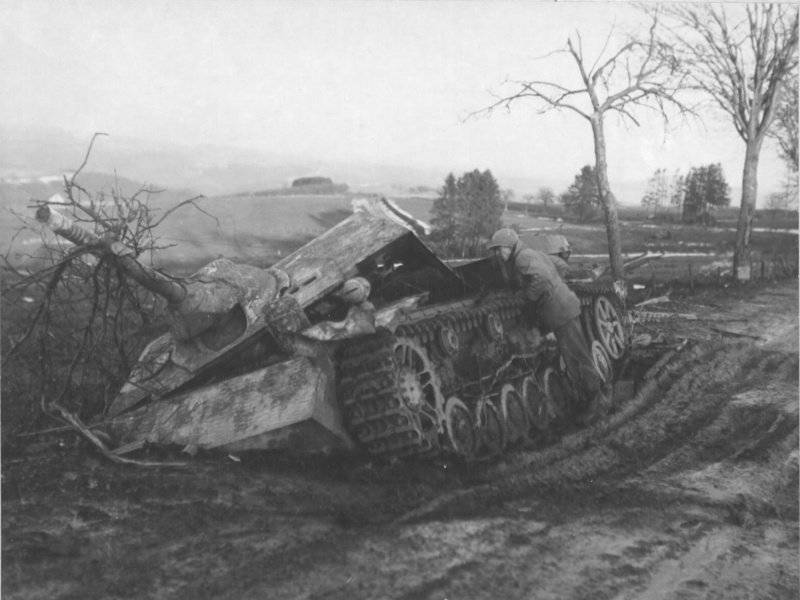
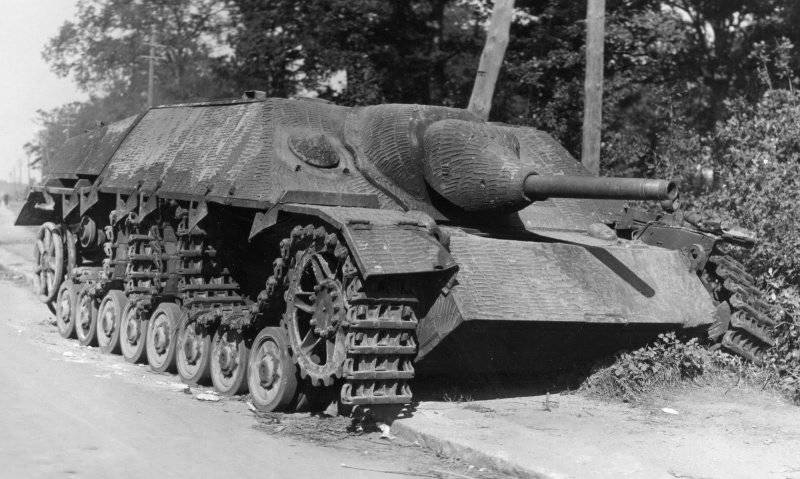
In May, 1944 re-armed the 49 division of the 4 tank division and the 53 division of the 5 tank division, on the Eastern Front.
The German army in France had an 6 Jagdpanzer IV for 1944 June: a Panzer-Lehr-Division 62 machine, a 31 Second Panzer Division machine, and a 12 Hitachjugend 21 Panzer Division tank machine. The rearmament process went through the entire second half of 10.
In Italy, 25 April completed the rearmament of the tank battalion of the division "Hermann Göring". In addition to the new commander, Walheuser obrieletenant, the division received the 21 fighter Jagdpanzer IV. After preparation, the division was redeployed to Tivoli. The tenth company, under the command of oberleutenant Karl-Heinz Göhring (who was the cousin of Field Marshal Herman Göring), held the front south of Livorno in the Salino region. May 27 battle took place with the "Shermans" of the American army. The Germans destroyed three tanks, two of which were on the account of the Feldwebel Coffin crew. Feldwebel Danke died in battle. In June, the division defended on personal sectors of the front, including the so-called “Klara” line under Kianvinchiano.
On July 15, the division was withdrawn from the front in the area of Florence-Bologna and rerouted by train to the east. July 22 from the warehouse Breslau-Gross Masselwitz entered the division 31 Jagdpanzer IV, while the old tank destroyers of the division were left in Italy. The July 26 division went to Warsaw from Hearnpoche station and then to Pilau. Otvotska district became a new place of its dislocation. During the battle of 28 July, the division destroyed two "Valentine" and the same T-34. The onboard screens brought many problems to the crews. Screens constantly clung to buildings and trees.
In the area of Pogozhely in 18: The 00 disguised T-34 destroyed the car for the non-commissioned officer Kanert. The crew of the tank destroyer died, only the commander of the vehicle could escape. The Soviet tank was inside the destroyed house and destroyed Kanert's Jagpanzer IV from a distance of several meters with three shells. The vehicles that came to the rescue of Kanert were also shot at, as a result of which the non-commissioned officer Hening lost the tank destroyer.
The Germans in the morning of July 29 knocked out one IP and burned two EC-2. Pozhogel in 13: 00 attacked a group of X-NUMX T-12 tanks. Jagdpanzer IV let the opponents cars almost close and opened fire. While the battle was fought, another group consisting of T-34, went into the rear of the German position, and knocked down three tank destroyers, including the machine of noncommissioned officer Schlöffel. Another couple of tank destroyers got stuck in the mud and were abandoned. For a while, Feldwebel Vaiganda’s machine restrained the enemy’s advance, but after hitting the caterpillar, she was forced to retreat to the rear for repair. The Germans lost the tank Pz.Kpfw. Iv. In the same battle killed the chieftain Lieutenant Göring, division commander.
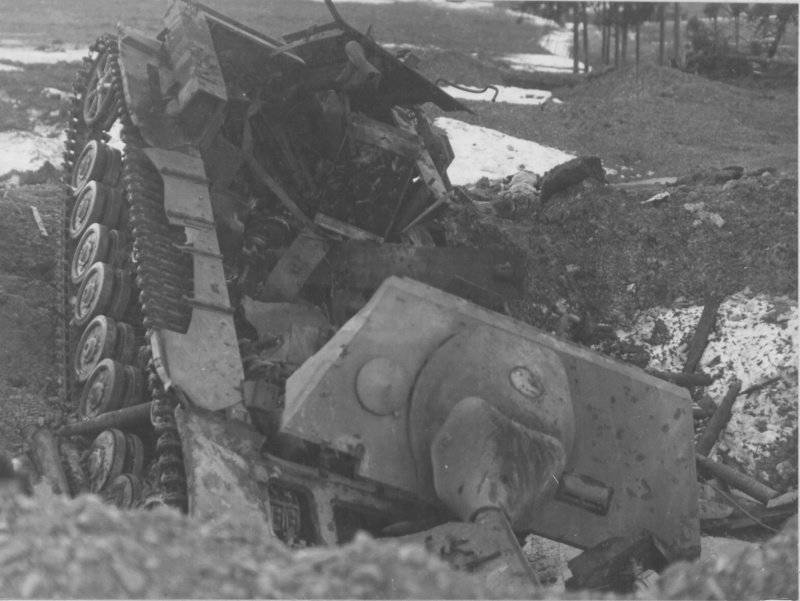
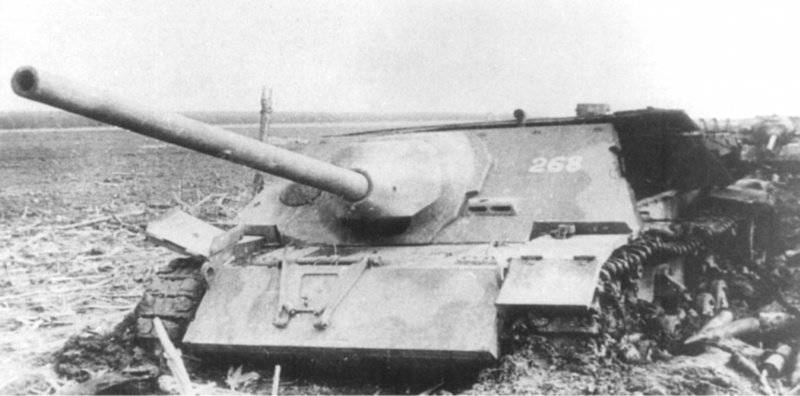
In the battles on the Western Front took part the Twelfth Division of the SS tank fighters of the Twelfth SS Panzer Division. The division was commanded by SS stormbanführer Hanrayh. The SS Obersharführer Rudolf Roy was considered the best soldier in the division, who commanded a platoon of the first company. Rudolf Rua in the early days of the battles in Normandy destroyed several Allied tanks. In the area of Emeville 20 July 1944, he hit another Sherman. The first company of 10 August entered the battle with the First Polish Tank Division. Two "Sherman" knocked out Untersharführer SS Ortlep. Rottenführer Fritz Eckstein, who was the gunner in the crew of the commander of the First Company, Obersturmführer Georg Hurdelbrink, burned eleven Polish tanks. Rua could boast only seven wrecked cars. Jagdpanzer IV of the Twelfth Division played a significant role during the German breakthrough from Faleza. They were often used as assault guns for paving the way for German units.
Since the autumn of the 1944, Jagdpanzer IV / 70 (V) has been coming in more and more quantities, equipped with long-barreled 75 mm guns.
The German army 30 December 1944 was equipped with 268 tank destroyers Jagdpanzer IV. On the Eastern Front operated 209 machines, on the Western Front - 59. The 174 machines were good.
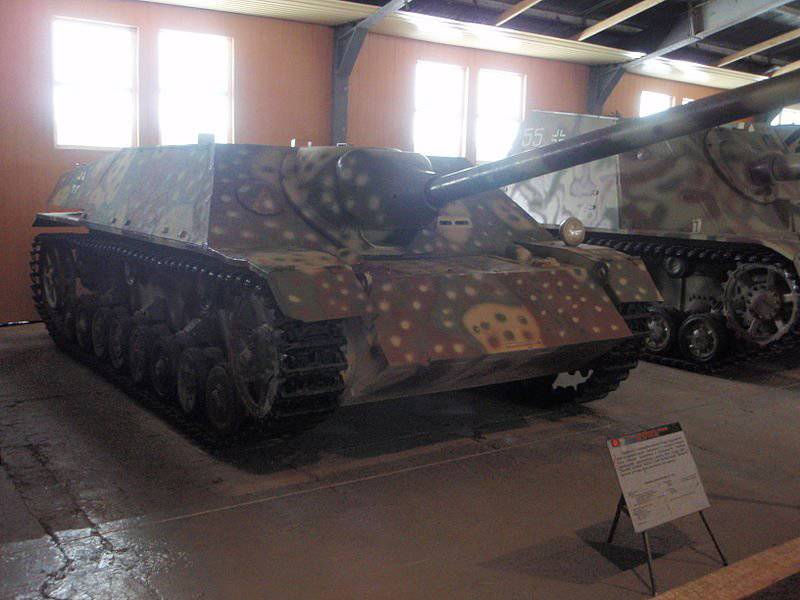
Color and designation
Jagdpanzer IV was stained in accordance with the rules that were adopted at the beginning of 1943 g. Usually there were cars with two or three-color camouflage, although there were instances of monochrome basic Wehrmacht Olive.
In winter, tank destroyers were covered with washed-out white winter camouflage or lime.
In the divisions of tank destroyers, the usual three-digit tactical number was used. The first number is a company in the division, the second is a platoon of its composition, the third is a car. For small divisions, this system was redundant. The number was usually painted in red or black, sometimes the numbers were surrounded by a white border. The girder cross was applied to the sides of the hull, rarely on board the deckhouse.
Emblems of units were rarely used in the fourth and one hundred and sixteenth tank divisions. The emblems were depicted on the rear wing and frontal armor. Wrecked tanks were sometimes designated on the gun barrel with white rings.
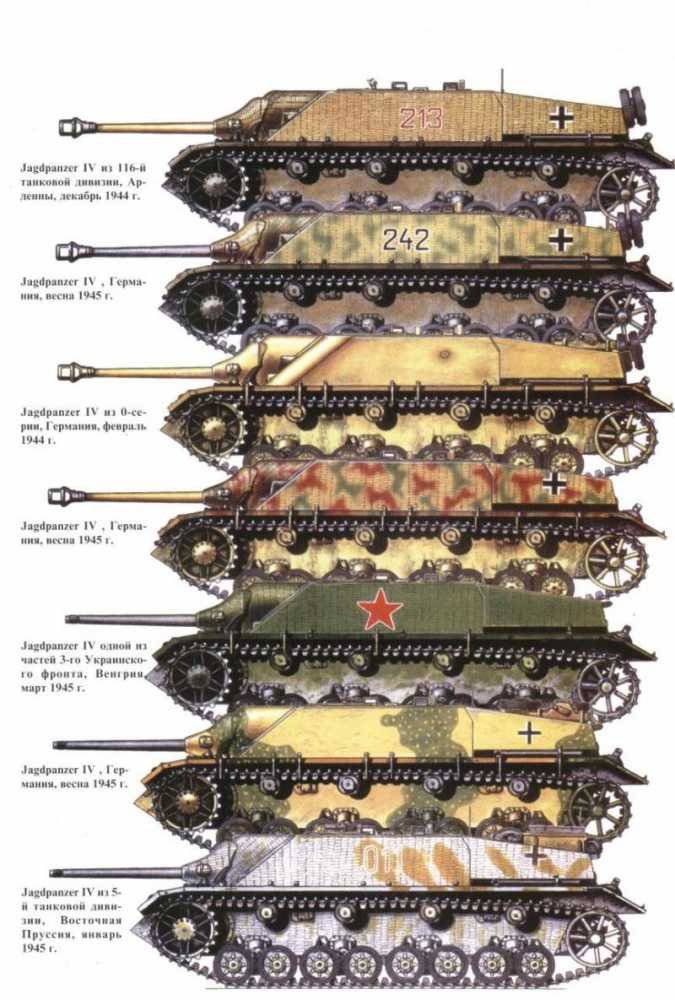
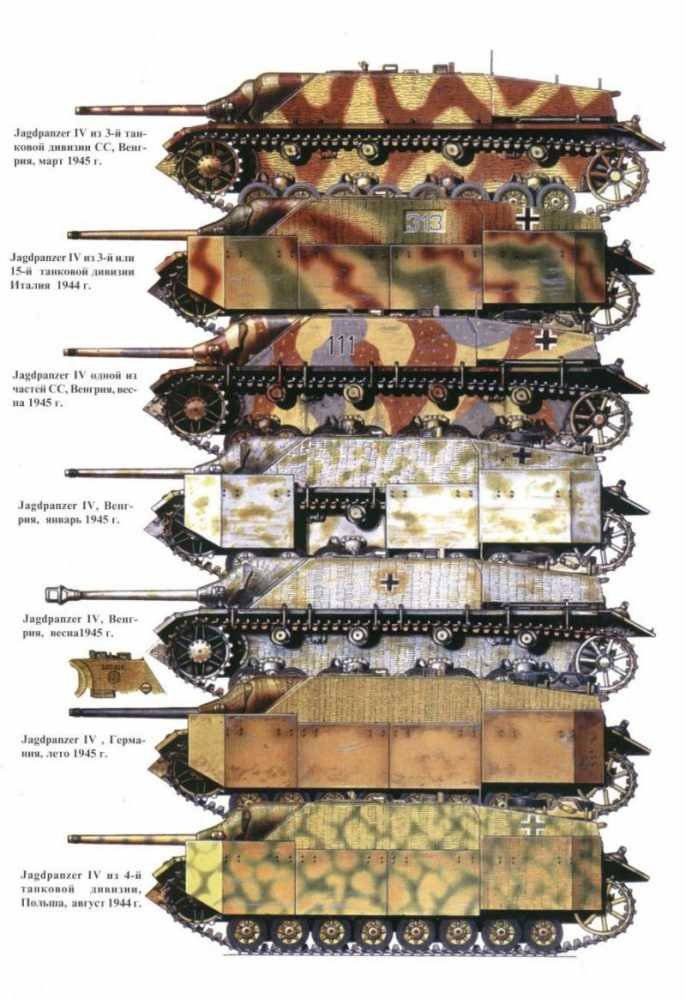
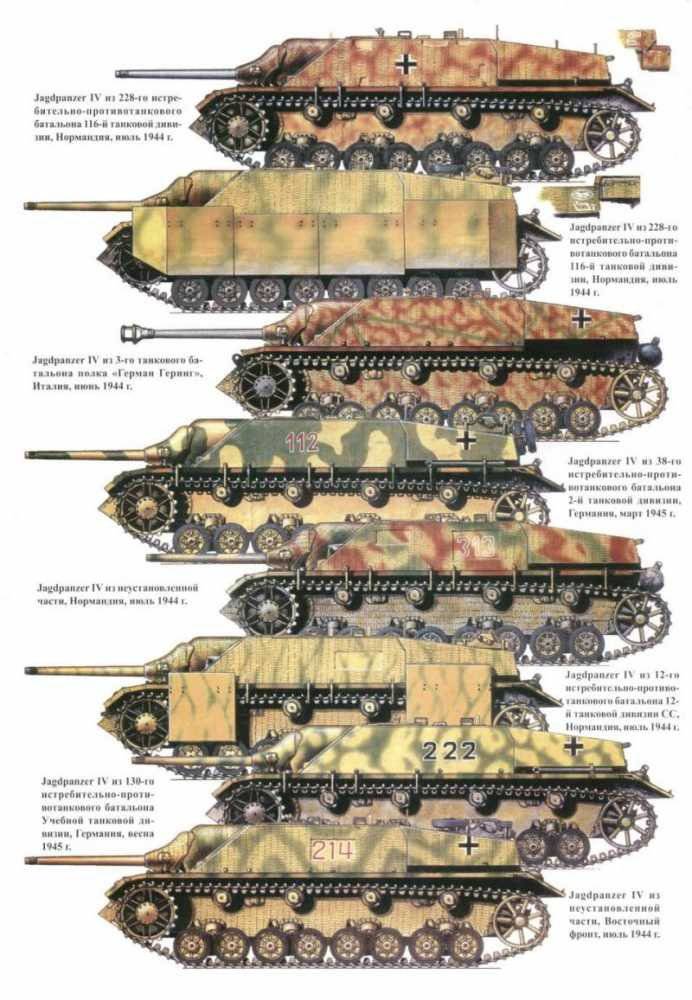
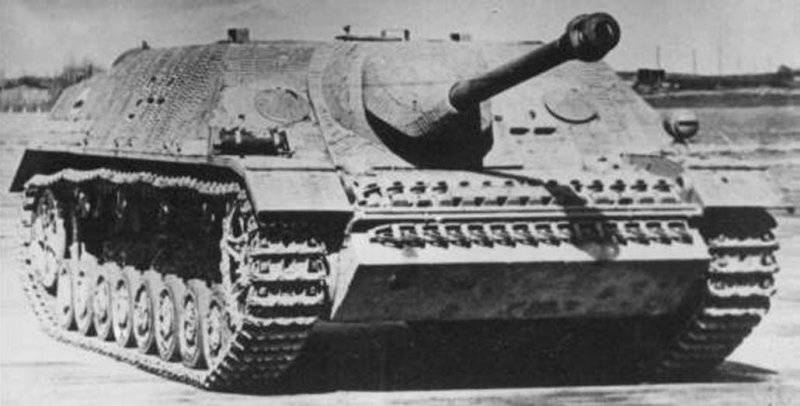
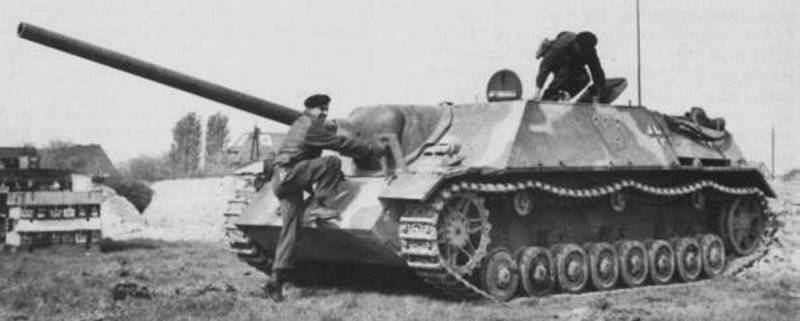
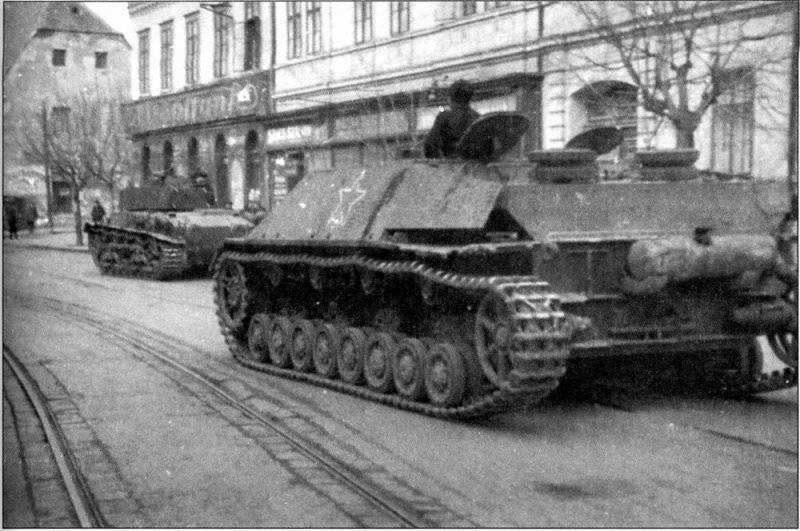
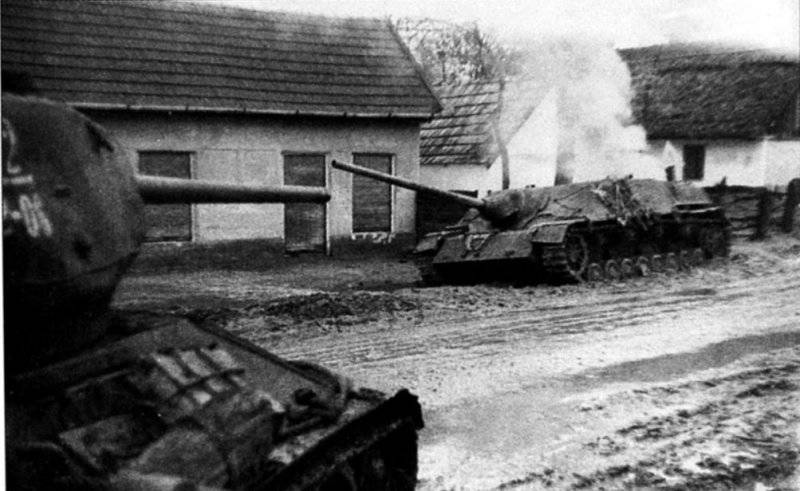
Information